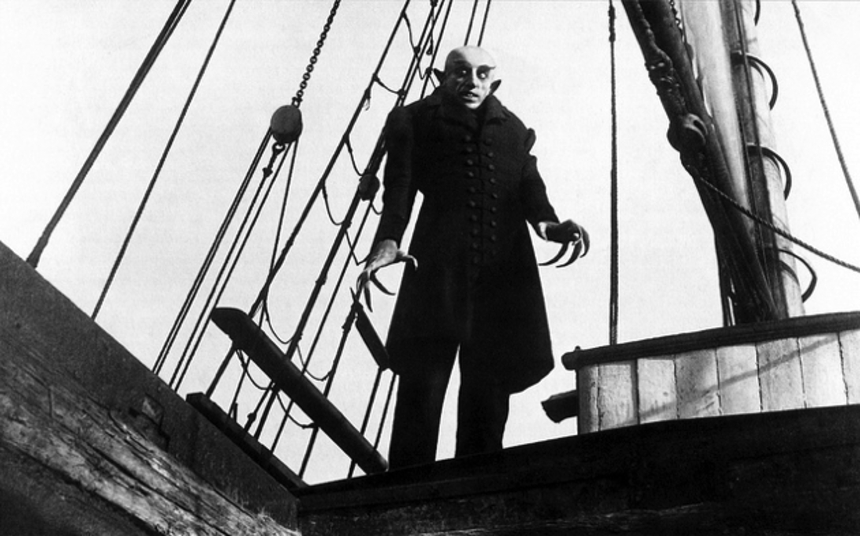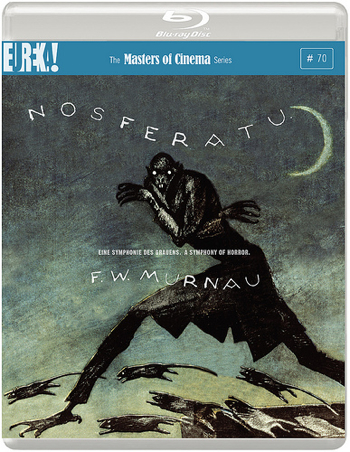Learning From The Masters Of Cinema: F.W. Murnau's NOSFERATU: A SYMPHONY OF HORROR

For a great many aspiring cinephiles, F.W. Murnau's Nosferatu: A Symphony Of Horror served as their entry point into both Silent Cinema and also German Expressionism. Perhaps because of the film's subject matter, rooted firmly in the horror genre, Murnau's thinly veiled adaptation of Bram Stoker's classic novel Dracula is perceived as more appealing and approachable than other films in the movement. Certainly much of the film's imagery is now synonymous with German Expressionism many decades later, while the fearsome appearance of its central antagonist, Count Orlok, has become an icon of cinematic horror. In truth, however, Nosferatu was made very much on the fringes of the German Film Industry, on a shoestring budget funded by renowned occultists.
On its release, Nosferatu was not a commercial success and was plagued by lawsuits from the Stoker estate. In part because of the film's lack of financing, Nosferatu's producers Prana Film went ahead with their adaptation of Dracula without securing the proper permissions in advance. The screenplay was penned by Henrik Galeen, the writer and director of the 1915 version of The Golem. As a strong believer in copyright and intellectual property, Galeen changed the title of his screenplay from Dracula to Nosferatu, and made numerous other changes to the narrative. Character names were all replaced, the action transposed from England to Germany and much of the plot and secondary characters stripped away. Desite Galeen's best efforts, however, there was no disguising the already famous and much-loved tale of a Transylvanian vampire who falls in love with his estate agent's beautiful fiancee.
Bram Stoker's widow, Florence, scored a series of resounding legal victories against the film, and all prints were ordered to be destroyed. Fortunately for Nosferatu, and subsequently for generations of film aficionados to come, prints of the film had already been sold overseas, and so the film was able to live on and avoid extinction. The same could not be said for Prana Film, whose vision of making occultist films to champion their cause fell at the first hurdle. Nosferatu would prove to be their only film production, and following their legal battles with the Stoker Estate, they filed for bankruptcy and shut up shop.
While Prana Film's ulterior motives for filmmaking were somewhat dubious, and their legal practices questionable, it is a shame that Nosferatu was their only film. Albin Grau, who produced the film for Prana alongside Enrico Dieckmann, was also responsible for the costumes, art direction, storyboarding and the overall look of the film. Today much of the credit for the film's success lies at the feet of its director, F.W. Murnau, but Nosferatu was as much Grau's vision as anyone else's. After the collapse of Prana Film, Grau would go on to work in the art and costume departments of a couple more German productions in the 1920s, but then the rise of the Nazis would put an end to his film career. Some reports claim that Grau died in a concentration camp during World War II, but information has subsequently come to light that he survived the ordeal and died peacefully in Bavaria in 1971.
At the time of Nosferatu, Murnau was already an established creative force. The great stage actor-director Max Reinhardt had seen Murnau's student work and invited him to join Reinhardt's prestigious acting school. After serving in World War I, Murnau set-up his own film studio with actor Conrad Veidt and by the time he was hired to work on Nosferatu had already dabbled in Gothic horror, with Der Januskopf, an unofficial adaptation of R.L. Stevenson's Strange Case of Dr. Jekyll and Mr. Hyde, starring Veidt alongside Bela Lugosi.

While very much brought on board as a director-for-hire, Murnau instilled Nosferatu with his own stylistic quirks and thematic interests, many of which can be seen again and again throughout his work. Most obviously is the central idea of a young couple plagued by monstrous external forces, which would be equally important in later masterpieces, Sunrise and Tabu. Technically, the film is extremely creative, making great use of light, shadow and colour tinting throughout to evoke specific moods and ideas. Murnau is even able to make the same locations seem at first romantic, and then later threatening, solely through his framing and lighting choices.
Perhaps the single greatest reason why Nosferatu has endured as well as it has, however, is because the film remains genuinely frightening even to this day. While much of that can be credited to Grau's demented set designs, Murnau's wonderful sense of mood and threat, and also Hans Erdmann's recently rescued original score, the horrors of Nosferatu begin and end with lead actor Max Schreck and his truly horrific portrayal of the vampire, Count Orlok. The performance is far more than simply a triumph by the make-up department - though hats off to them for creating a monster as memorable as Karloff's creature from Frankenstein - but in its inhuman physicality. Orlock moves likes a corpse stricken with rigor mortis, rigid and contorted, with a piercing hungry gaze and with the vile appearance of a starved and shaved half-rat/half-bat man. In his wonderful film on the making of Nosferatu, Shadow of the Vampire, E. Elias Merhige goes so far as to suggest Schreck was in fact one of the undead in real life (brilliantly portrayed by an Oscar-nominated Willem Dafoe).
Masters of Cinema released a hugely impressive 2-disc DVD set of Nosferatu back in 2007, but their new Blu-ray release bests even that comprehensive package - both in terms of audio-visual quality and supplemental material. Everything from that earlier release makes its way onto the new Blu-ray, including an impressively academic and bountiful audio commentary from R. Dixon Smith and Brad Stevens, together with the excellent German documentary, The Language of Shadows, about Murnau and the making of the film. That earlier release also included an epic 80-page book, containing writing from Gilberto Perez, Albin Grau, Enno Patalas and Craig Keller, all of which makes it across save for No End To Nosferatu, an essay by Thomas Elsaesser.
More than making up for that single omission, however, is a brand new audio commentary by film historian David Kalat, which must be the most intellectually stimulating and simultaneously laugh-out-loud funny commentary track I have ever heard. Taking a smart, informed, yet somewhat fresh stance on the film and its legacy, Kalat sets out to dispel some of the myths surrounding the film and its production, as well as discuss a number of new takes on the film and its themes. There is a new video interview with Kevin Jackson, author of BFI Film Classics: Nosferatu, as well as an exclusively recorded video piece from director Abel Ferrara, who was influenced heavily by the film in his own King of New York and The Addiction. All of which complements a gorgeous new 1080p high-definition restoration of the film by Frederich-Wilhelm-Murnau-Stiftung which looks absolutely incredible, coupled with a choice of stereo and 5.1 audio tracks.
As someone who already owns the Masters of Cinema's 2007 DVD release, this upgrade is a no-brainer. Nosferatu: A Symphony of Horror is a pillar of German Expressionism, a landmark horror film and one of the most thrilling and entertaining silent films you will ever see. More than 90 years after it was made, it retains the power to chill your bones and haunt your dreams with its nightmarish imagery, inhuman performances and quintessential (if not entirely legitimate) interpretation of one of gothic literature's most indelible creations.
Nosferatu: A Symphony of Horror is released in the UK on Blu-ray, dual format Blu-ray and DVD steelbook and DVD from Eureka Entertainment's Masters of Cinema series today.

Do you feel this content is inappropriate or infringes upon your rights? Click here to report it, or see our DMCA policy.






